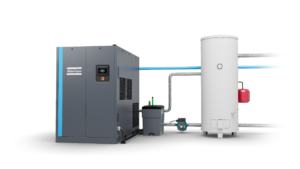A UK Guide to Air Compressor Heat Recovery
Approximately 94% of the electrical energy an air compressor uses is converted into heat. In most businesses, that’s paid-for energy down the drain.
This process creates an additional expense, as fans or HVAC systems are often required to remove the heat generated by the compressor from the compressor room.
Air compressor heat recovery is a technology that captures and repurposes this waste heat. It allows businesses to reduce other energy costs by using the heat for practical applications.
Sustainability and UK Compliance
Meeting efficiency targets in line with sustainability goals and regulatory standards is a key motivation for many companies to improve their efficiency.
Air compressor heat recovery helps companies to meet these targets.
Heat from an air compressor doesn’t have to go to waste. When it’s recovered and used for space heating, the need for fossil fuels drops. That simple shift leads to lower CO₂ emissions across the whole facility.
As a result, air compressor heat recovery directly helps companies to meet various UK government schemes and standards. These include:
- Energy Savings Opportunity Scheme (ESOS)
- Streamlined Energy and Carbon Reporting (SECR)
- ISO 50001 Energy Management Systems
How Air Compressor Heat Recovery Works
Heat is an unavoidable result of air compression. A heat recovery system works by intercepting the compressors’ cooling process to capture this thermal energy.
There are two primary recovery methods.
Hot Air Utilisation
This is the simplest method. Ducting captures the hot air used to cool the compressor. It then redirects it for space heating.
- Best for: Heating workshops, warehouses, and loading bays.
- Efficiency: Recovers up to 94% of the input energy as warm air.
- Limitation: The heat is mainly useful during colder months.
Hot Water Generation
This method uses a heat exchanger to transfer thermal energy from the compressors’ cooling circuit into a water system.
- Best for: Process heating, boiler pre-feeding, and sanitary hot water.
- Efficiency: Produces hot water at up to 90°C. That heat can directly replace natural gas or oil for water heating, leading to savings all year round.
- Advantage: This method reliably delivers a more sizable return on investment. This is due to the constant demand for hot water in most facilities.

A UK Guide to Air Compressor Heat Recovery
Atlas Copco Systems
William G. Search Ltd. (Search Air) is a Premier Distributor for Atlas Copco, providing systems engineered for performance.
- Integrated Systems (GA Series): Atlas Copco’s oil-injected GA screw compressors can be equipped with integrated heat recovery units, recovering up to 80% of waste heat.
- High-Grade Heat (Z-Series): For industries needing oil-free air, the water-cooled Z-series compressors recover up to 94% of input power as high-grade hot water at 85-90°C.
The Business Case for Air Compressor Heat Recovery
Implementing a system is a practical financial decision.
Rapid ROI and Lower Energy Costs
The main benefit is a direct reduction in purchased energy. The captured heat displaces natural gas or oil that would otherwise be used for heating processes. This provides a hedge against volatile UK energy prices.
A typical 75 kW compressor can recover over 60 kW of thermal energy. For a facility running two shifts, this can result in annual savings of over £7,800 on gas bills, delivering payback in just 18–24 months.
Improved Compressor Reliability
A properly designed heat recovery system is also an improved cooling system.
It lessens the thermal stress on major components, potentially lengthening the life of the machine and increasing reliability. This helps to make your air compressor more efficient.
Practical Applications in UK Industry
Repurposed heat can be used in many ways:
- Space Heating: Warming workshops, production halls, and logistics warehouses.
- Process Heating: Supplying hot water for cleaning in food & beverage, parts washing in automotive, and dyeing in textiles.
- Boiler Pre-feeding: Reducing the fuel required to generate process steam.
- Sanitary Water: Providing hot water for canteens, showers, and washrooms.
Retrofitting an Existing Compressor
It is possible to retrofit heat recovery to most existing industrial compressors.
While integrating the system during a new installation is straightforward, a retrofit is a common solution. A successful retrofit requires expert planning to ensure the new components work with the compressors’ existing cooling circuit and controls.
Implementation and Next Steps
A successful project matches the heat produced by your compressors with a consistent use for that heat in your facility.
The process should begin with a professional energy audit. An assessment will analyse your compressors, load profile and map your facility’s thermal demands.
This ensures the system is correctly specified and installed.
Why Choose Atlas Copco Systems?
Atlas Copco systems are distinguished by their deep integration and intelligent controls.
| Feature | Atlas Copco | Other Brands |
| Integrated Systems | Factory-fitted options ensure seamless performance. | Often sold as add-on kits. |
| Intelligent Controls | Can prioritise compressors to match heat demand. | May lack system-level optimisation. |
| Advanced Monitoring | SMARTLINK tracks real-time savings. | Monitoring capabilities vary. |
These features, managed through air compressor monitoring systems, provide a more complete approach to energy management.
Learn More About Heat Recovery
Air compressor heat recovery is a practical way to reduce energy costs and improve your facility’s efficiency.
To learn more, contact the experts at Search Air. We can arrange a free, no-obligation #airCHECK to assess your facility’s potential for heat recovery.

